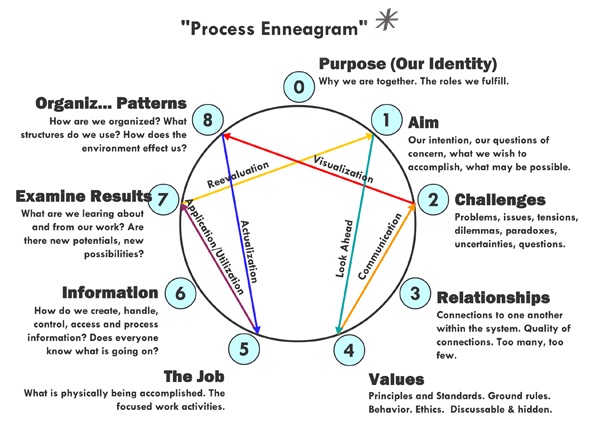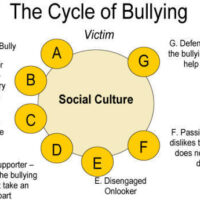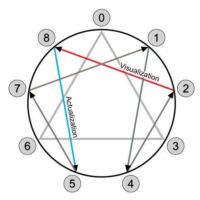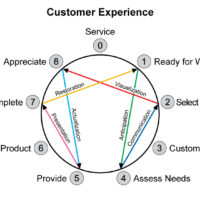My business background is in the Performing Arts, Education & Consulting with an emphasis on understanding structures that help us keep sight of the big picture while we integrate and improve the parts of a process. Basically that’s process improvement, but it’s actually more than that.
When studying Knowles’ Process Enneagram*, one can see — at point 8 — the Structures surrounding our Work or Job at point 5 have a dramatic influence over our effectiveness.
Note: To read this along with the symbol, especially if you are new to this way of “NTS Thinking”, it helps to have the symbol printed and in front of you or to arrange two browser windows to see the NTS and the text here simultaneously. (A Nine Term Symbol, an “NTS”, is also referred to as an enneagram.)
Our Relationships at point 3 can be tuned in order to serve the activity and to process the information (6) efficiently.
When Knowles speaks of Information (6), he means all of the data, facts and ongoing torrent of information about anything at all related to our work.
Some companies control this flow and restrict it to the point where it slows down the productivity while others may not restrict it enough to keep precious information from the competition. There is a need for everyone to have access to the pertinent information to perform their role and for the Relationships (3) to utilize the Information such that line 5-7 can serve to combine the Job and the Information in the most effective way. (Naturally, the LINE does not do it, people do. This is “NTS language”.)

To make a living as a magician (as I have for nearly 30 years), or in any arts business where you’re selling something that is not like food or shelter, you not only have to love what you do, but you have to be efficient.
By listening to the needs of my business, I ended up paying attention to the structures that contribute to and support: efficiency, sustainability, and choosing effective actions within a whole system. This is point 8 in the Knowles Nine Term Symbol. What he shows through hands on experience is that groups can use this to become Self Organizing very quickly. Why? Because at point 8, where the Organizational Structures support the Job (point 5), we can create the best structures for our business. We can form these structures together! But we need to be able to move through our work flow using the inner lines (The Compass) in addition to everything else.
In any case, as a bi-product of working like this, I wound up with a tangible tool for sustainable change and process improvement. It is called the NTS, and I share it in my book called Accomplish The Impossible. Anyone who has studied this can quickly see that the one above works wonders in a consulting scenario. I demonstrate it through Workshops. And the NTS in general has turned into an online web tool that enables users to create, share and store their ideas while they look at problems, come up with solutions, and share understanding across disciplines.
The primary benefit of using a specific structure for clarifying aims and ideas is that when the structure matches the needs of the activities, it enables people—individuals and teams—to become self organizing and to gather the emotional commitment and will to carry a process to completion. And this can happen very quickly when working with the NTS featured here.
Too often people move forward on a plan without a way to collectively organize their ideas and without a common language so they can communicate about ongoing results. Now this works when a company has momentum and big bucks are flying in the door. But when an effort is new or when it’s geared up to reform an old system, what’s needed then is a new pattern. A new pattern that’s inclusive and more consciously organized (than the old ones) so that people can stay ahead of the game instead of just reacting to circumstances.
That’s what we do in addition to providing shows. We create whole systems technologies that are results oriented and range from very simple to complex enough to deal with large projects. My experience with structures has given me the insight to recognize that Richard Knowles, in his book The Leadership Dance, has pin pointed one of the most useful Nine Term Symbols for restoring and transforming corporate activity from uncertainty into action toward values and aims. There is no doubt after reading his work (available here) that his many years of experience and direct application at DuPont and other companies have advanced the practical uses of what he calls “the Process Enneagram”.
(*The Process Enneagram © by Richard Knowles is used here with permission from the author. The labels on the six Inner Lines are from the book Accomplish The Impossible by Steffan Soule.)





